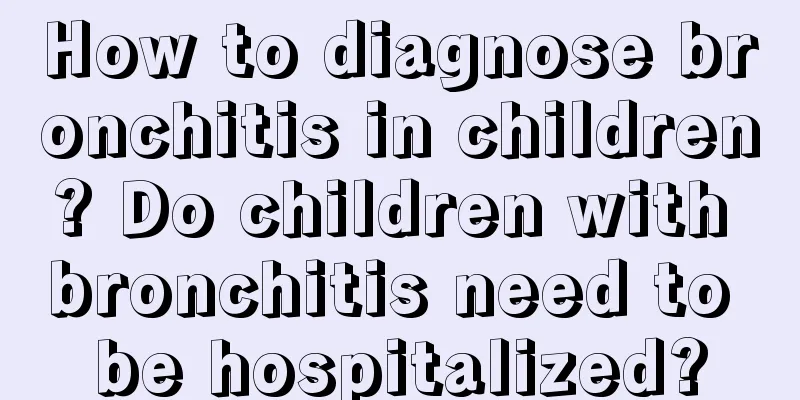How to diagnose bronchitis in children? Do children with bronchitis need to be hospitalized?

|
After the baby is born, the body's immunity is poor, and it is easy to be infected by bacteria and viruses, causing respiratory diseases. Winter is the peak season for pediatric bronchitis, so more attention should be paid to the baby's living environment. How to diagnose bronchitis in childrenGenerally speaking, if a baby has bronchitis, he or she may have long-term and recurrent coughs, especially if the child coughs frequently in the morning and evening. In this case, the sputum coughed up by the baby is mostly white and sticky, or foamy, and in severe cases, there may even be mucopurulent sputum. In addition, some children with bronchitis may also wheeze and cry. The symptoms of infant tracheitis are mostly caused by infection of the upper respiratory tract. Some children may develop the disease rapidly, while others may develop it slowly. This type of disease is often caused by the child's decreased body resistance. After being infected by viruses, bacteria and other substances, acute inflammation such as bronchitis will occur. If you want to confirm the diagnosis, it is recommended to go to a pediatric hospital for examination. Do children with bronchitis need to be hospitalized?When a baby has bronchopneumonia, whether he needs to be hospitalized depends on the severity of the disease and the factors causing the respiratory infection. After a systematic examination, if the baby's condition is relatively mild and the symptoms are not obvious, there is no need for hospitalization. Just intravenous infusion in the outpatient clinic, combined with oral medication, nebulization and other treatment methods, the child can usually recover in 1-2 weeks. If the child's bronchopneumonia is more serious, it cannot be treated only in the outpatient clinic, and the child should be hospitalized for systematic treatment. What tests should be done for acute bronchitis in children1. Chest X-ray examination: thickening of lung texture or normal, with occasional thickening of hilar shadows. Severe bronchitis is difficult to distinguish from early pneumonia. If you hear deeper rales or crepitus, and the rales do not significantly decrease after coughing, pneumonia should be considered and a chest X-ray examination should be performed to confirm the diagnosis. 2. Blood biochemical examination: The total number of peripheral blood leukocytes is normal or low. When the infection is caused by bacteria or combined with bacterial infection, the total number of leukocytes is increased and the neutrophilia increases. How many days will it take for baby's tracheitis to heal?The onset is relatively acute, with early cold symptoms, such as coughing and sneezing. After 1 to 2 days, the cough worsens, and paroxysmal dyspnea, wheezing, pale complexion, cyanosis of the lips, and concave signs appear. The early signs of the lungs are mainly wheezing, followed by wet sounds. When the symptoms are severe, they may be accompanied by congestive heart failure, respiratory failure, hypoxic encephalopathy, and water and electrolyte disorders. The body temperature generally does not exceed 38.5℃, and the course of the disease is 1 to 2 weeks. |
<<: How can I choose a more original name? How can I choose a name with less repetition?
Recommend
How long should infant rice cereal be eaten? When should infant rice cereal be added?
In our daily life, we often see mothers feeding t...
A complete guide to easily prepare complementary foods for babies before one year old
When the baby is four or five months old, mothers...
What is the reason for the odor down there after childbirth? What should I do if there is an odor down there after childbirth?
It has been more than 10 days since I had a norma...
Can babies eat glutinous rice balls? How old should babies be to eat glutinous rice balls?
The Lantern Festival is coming soon. Every family...
What is the reason for the white spots on the newborn's neck? What should I do?
Babies always love to play, and their bodies alwa...
How to make baby rice cereal? What are the precautions for babies to eat rice cereal?
Babies can start eating complementary foods from ...
What should I do if my baby cries after getting an injection? Don’t use these wrong methods
The so-called vaccination is to vaccinate a healt...
At what age can a baby eat by himself? How to make a baby love eating?
Learning to eat by yourself is a stage that your ...
How to apply for a newborn medical insurance card? New parents must know
Newborn babies have low immunity and are prone to...
Is it better for pregnant women to sleep on the left side or the right side? Sleeping on the left side is the most comfortable
Many pregnant women often don't know which sl...
How to pinch the middle finger to tell the gender of the baby during pregnancy Which month in 2020 is more likely to give birth to girls
Many mothers are curious about the gender of thei...
How to treat prenatal depression How to self-regulate prenatal depression
Prenatal depression is a disease with a low proba...
What is Panax notoginseng powder? What are the effects of Panax notoginseng powder?
Do you know what Panax notoginseng powder is? May...
Can baby food be refrigerated? How long can baby food be frozen?
It is very laborious to prepare complementary foo...
Why is the baby's spit-up a bit sticky? Will the baby's spit-up cause pneumonia?
It is normal for babies to spit up milk, because ...









